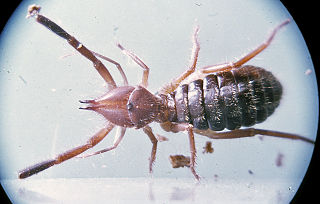Syndaesia mastix is a species of arachnids in the order Solifugae, and the only member of the genus Syndaesia. It lives in western Argentina, and is one of only two daesiids in South America, the other being Ammotrechelis goetschi from the Atacama Desert; all other South American solifugids are in the families Eremobatidae and Ammotrechidae.

Solifugae is an order of animals in the class Arachnida known variously as camel spiders, wind scorpions, sun spiders, or solifuges. The order includes more than 1,000 described species in about 147 genera. Despite the common names, they are neither true scorpions, nor true spiders. Most species of Solifugae live in dry climates and feed opportunistically on ground-dwelling arthropods and other small animals. The largest species grow to a length of 12–15 cm (5–6 in), including legs. A number of urban legends exaggerate the size and speed of the Solifugae, and their potential danger to humans, which is negligible.

Ammotrechidae is a family of solifuges distributed in the Americas and the Caribbean Islands. It includes 26 described genera and 95 species. Members of this family can be distinguished from members of other families by the absence of claws on tarsi of leg I, tarsal segmentation 1-2-2-(2-4), pedipalps with pairs of lateroventral spines, and by males having an immovable flagellum on the mesal face of each chelicerum. The propeltidium of the Ammotrechidae is recurved.

The Museu Paraense Emílio Goeldi (MPEG) is a Brazilian research institution and museum located in the city of Belém, state of Pará, Brazil. It was founded in 1866 by Domingos Soares Ferreira Penna as the Pará Museum of Natural History and Ethnography, and was later named in honor of Swiss naturalist Émil August Goeldi, who reorganized the institution and was its director from 1894 to 1905. It is now the "main research center on natural systems and sociocultural processes of the Brazilian Amazon." The museum and zoological park are listed as protected sites by both the National Institute of Historic and Artistic Heritage (IPHAN) and the Department of Historic, Artistic and Cultural Heritage of the state of Pará.

Emilio Eduardo Massera was an Argentine Naval military officer, and a leading participant in the Argentine coup d'état of 1976. In 1981, he was found to be a member of P2, a clandestine Masonic lodge involved in Italy's strategy of tension. Many considered Massera to have masterminded the junta's Dirty War against political opponents, which resulted in over 30,000 deaths and disappeances.

Club Atlético Talleres is an Argentine sports club from the city of Córdoba. The institution is mostly known for its football team, which currently plays in the Argentine Primera División. Talleres' main rival is Belgrano: Their rivalry is known as "el clásico cordobés".

List of Commanders-in-Chief of the Peruvian Army since the creation of that post on March 12, 1953.

Daesiidae is a family of solifugids, which are widespread in Africa and the Middle East. Members of the family are also present in India, Italy, South America, the Balkans, and the single species Gluvia dorsalis in the Iberian Peninsula. A single fossil species is known from Eocene Baltic amber.

The Salta–Antofagasta railway, also named Huaytiquina, is a non-electrified single track railway line that links Argentina and Chile passing through the Andes. It is a 1,000 mmmetre gauge railway with a total length of 941 km, connecting the city of Salta (Argentina) to the one of Antofagasta (Chile), on the Pacific Ocean, passing through the Puna de Atacama and Atacama Desert.

Emilio Ambasz is an Argentinian-US architect and award-winning industrial designer. From 1969 to 1976 he was Curator of Design at the Museum of Modern Art, in New York. Ambasz has been labeled as "the father, poet, and prophet" of the green architecture by Japanese architect Tadao Ando.
Dasycleobis is a monotypic genus of ammotrechid camel spiders, first described by Cândido Firmino de Mello-Leitão in 1940. Its single species, Dasycleobiscrinitus is distributed in Argentina.
Mortola is a monotypic genus of ammotrechid camel spiders, first described by Cândido Firmino de Mello-Leitão in 1938. Its single species, Mortola mortola, is distributed in Argentina.
Xenotrecha is a monotypic genus of ammotrechid camel spiders, first described by Emilio Antonio Maury in 1982. Its single species, Xenotrechahuebneri is distributed in Brazil and Argentina.
Eutrecha is a monotypic genus of ammotrechid camel spiders, first described by Emilio Antonio Maury in 1982. Its single species, Eutrecha longirostris is distributed in Venezuela.
Oltacola is a genus of ammotrechid camel spiders, first described by Carl Friedrich Roewer in 1934.
Chileotrecha is a monotypic genus of ammotrechid camel spiders, first described by Emilio Antonio Maury in 1987. Its single species, Chileotrechaatacamensis is distributed in Chile.
Nothopuga is a genus of ammotrechid camel spiders, first described by Emilio Antonio Maury in 1976.
Pseudocleobis is a genus of ammotrechid camel spiders, first described by Reginald Innes Pocock in 1900.








